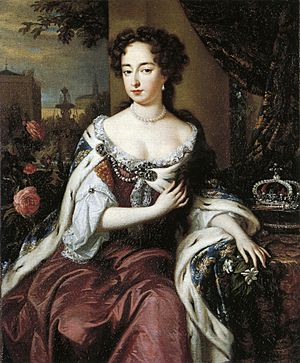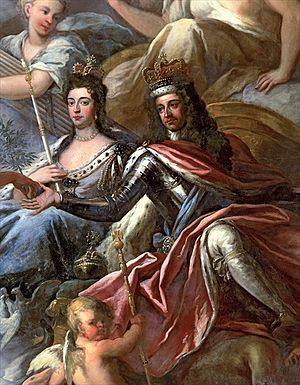Mary II of England facts for kids
Quick facts for kids Mary II |
|
|---|---|

Portrait by Godfrey Kneller, 1690
|
|
| Queen of England, Scotland, and Ireland (more...) | |
| Reign | 1689 – 28 December 1694 |
| Coronation | 11 April 1689 |
| Predecessor | James II |
| Successor | William III & II |
| Co-monarch | William III & II |
| Princess consort of Orange | |
| Tenure | 4 November 1677 – 28 December 1694 |
| Born | 30 April 1662 [NS: 10 May 1662] St James's Palace, Westminster, England |
| Died | 28 December 1694 (aged 32) [NS: 7 January 1695] Kensington Palace, Middlesex, England |
| Burial | 5 March 1695 Westminster Abbey, London |
| Spouse | |
| House | Stuart |
| Father | James II of England |
| Mother | Anne Hyde |
| Religion | Anglicanism |
| Signature | |
Mary II (born April 30, 1662 – died December 28, 1694) was the Queen of England, Scotland, and Ireland. She ruled alongside her husband, King William III and II, from 1689 until her death in 1694. Their time ruling together is often called the reign of William and Mary.
Mary was born when her uncle, King Charles II, was on the throne. She was the oldest daughter of James, Duke of York (who later became King James II), and his first wife, Anne Hyde. Even though her parents became Roman Catholic, Charles II made sure Mary and her sister Anne were raised as Anglicans.
Because Charles II had no legal children, Mary was second in line to the throne. At 15, she married her cousin, William of Orange, who was a Protestant. When Charles II died in 1685, James became king, making Mary the next in line.
King James II tried to rule without Parliament. He also had a son from his second marriage, James Francis Edward. These events led to James being removed from power in the Glorious Revolution of 1688. After this, the English Bill of Rights was created.
William and Mary then became joint rulers. Mary usually let her husband lead when he was in England. William was a famous military leader. But when William was away fighting, Mary took charge. She proved to be a strong and effective ruler. Mary died from smallpox at age 32. William then ruled alone until his death in 1702. Mary's sister, Anne, became queen after him.
Contents
Mary's Early Life
Mary was born in London at St James's Palace on April 30, 1662. She was the first daughter of James, Duke of York, who would become King James II & VII. Her mother was Anne Hyde. Mary's uncle was Charles II, who ruled England, Scotland, and Ireland. Her grandfather, Edward Hyde, 1st Earl of Clarendon, was a main advisor to King Charles.
Mary was baptized as an Anglican at the Chapel Royal. She was named after her ancestor, Mary, Queen of Scots. Most of her brothers and sisters died very young. Only Mary and her younger sister Anne survived. King Charles II had no legal children. This meant Mary was often second in line to the throne, after her father.
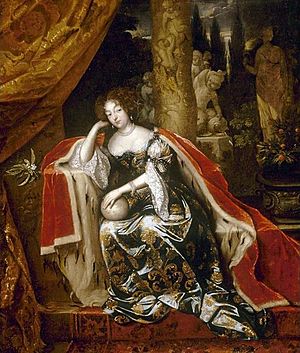
Mary's father became a Roman Catholic around 1668. Her mother had converted earlier. But Mary and Anne were raised as Anglicans, as King Charles II wished. They lived at Richmond Palace with their governess, Lady Frances Villiers. They only visited their parents or grandfather sometimes.
Mary's education focused on music, dance, drawing, French, and religious lessons. Her mother died in 1671. In 1673, her father married again to Mary of Modena. Mary of Modena was Catholic and only four years older than Mary.
At age 15, Mary was set to marry her cousin, William III of Orange. He was a Protestant leader in Holland. William was fourth in line to the throne after James, Mary, and Anne. King Charles II first wanted Mary to marry the French heir, Dauphin Louis. This would have made Britain closer to Catholic France. But Parliament pushed for the marriage to William. King Charles agreed.
Mary's father, James, also agreed. He thought it would make him more popular with Protestants. When James told Mary about the marriage, she cried for two days.
Marriage to William
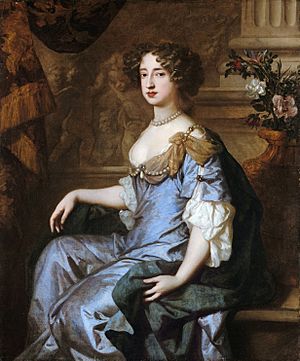
William and Mary were married on November 4, 1677, at St James's Palace. Bishop Henry Compton performed the ceremony. Mary was sad to leave her home. She traveled with William to the Netherlands later that month. Bad weather delayed their journey for two weeks. They landed at a small village and walked through the cold countryside. Then coaches took them to Huis Honselaarsdijk. On December 14, they had a grand parade into The Hague.
Mary was lively and friendly. The Dutch people liked her very much. Her marriage to a Protestant prince was also popular in Britain. She was very dedicated to William. However, William was often away fighting wars. This made Mary's family think he was cold and didn't care enough.
Mary and William hoped to have children, but sadly, they did not have any that survived. This was a great sadness for Mary.
In 1684, James Scott, Duke of Monmouth, who was King Charles II's unofficial son, lived in the Netherlands. William and Mary welcomed him. Some people saw Monmouth as a possible Protestant king instead of James. But William did not think Monmouth had enough support.
Even though they started out a bit distant, Mary and William grew very close. Their strong shared Protestant faith helped bring them together.
James Becomes King
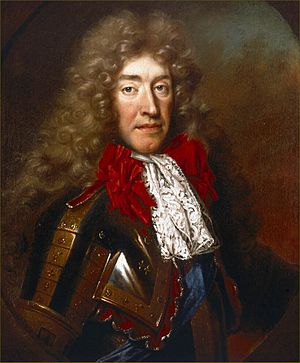
King Charles II died in February 1685 without any legal children. Mary's father, James, became King James II in England and Ireland, and James VII in Scotland. Mary was playing cards when William told her the news. She knew she was now the next in line to the throne.
Monmouth, King Charles's unofficial son, gathered an army in Amsterdam. He then sailed to Britain to try and take the throne. William told James about Monmouth's plan. He also ordered English soldiers in the Netherlands to return to Britain. Monmouth was defeated and executed. William and Mary were upset by some of James's actions after this.
King James had strong religious ideas. He tried to give freedom of religion to non-Anglicans. He did this by stopping Parliament's laws with his own royal orders. Many people did not like this. Mary thought this was against the law. Her chaplain wrote a letter to the archbishop of Canterbury, William Sancroft, saying this for her.
Mary was also upset when the Catholic King of France, Louis XIV, attacked Orange. He treated Huguenot refugees badly there, and James did not help. James tried to cause trouble between William and Mary. He encouraged Mary's staff to tell her that William was seeing Elizabeth Villiers. Mary caught William leaving Villiers's room late at night. William denied it, and Mary seemed to believe him. They might have been meeting to share secret information. Mary then sent her staff back to Britain.
The Glorious Revolution
Some unhappy Protestant politicians and nobles started talking to William in 1686. King James made Anglican church leaders read his Declaration of Indulgence in their churches. This paper gave religious freedom to Catholics and dissenters. After this in May 1688, James became even less popular.
Protestants became more worried when James's wife, Mary of Modena, had a son in June 1688. This son, James Francis Edward, would be raised Catholic. This was different from Mary and Anne. Some people claimed the baby was not really the Queen's. They said he was secretly brought into the room. Mary sent questions to her sister Anne about the birth. Anne's answers and other rumors made Mary suspect the child was not her real brother. She thought her father was trying to make sure a Catholic would rule after him.
On June 30, seven important English nobles secretly asked William to come to England with an army. They wanted him to remove James from power. Mary told William she did not want political power. She said she would be only his wife and would help him become king for life. She promised to always obey him, as she had in her marriage vows.
William agreed to invade. He said James's newborn son was "pretended." He also listed the English people's complaints. William stated his goal was to have a "free and lawful Parliament." After being turned back by storms in October, William and his Dutch army landed in England on November 5, 1688. Mary stayed in the Netherlands.
The English Army and Navy joined William. On December 11, King James tried to escape but was caught. He tried again on December 23 and succeeded. William purposely let James escape to France. James lived there in exile until he died.
Mary was sad about her father being removed. She felt torn between caring for him and her duty to William. But she believed William's actions were needed to "save the Church and State." When Mary came to England, she felt "secret joy" to be home. But she also felt sad about her father's problems. William told her to look happy when they arrived in London. Because of this, some people criticized her for seeming cold about her father's situation.
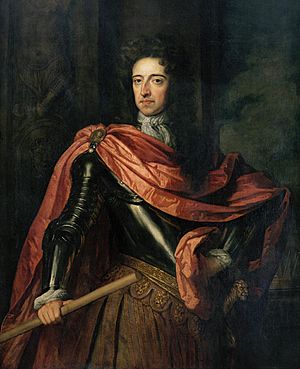
In January 1689, a Parliament met. They discussed what to do next. Some people thought Mary should be the only queen. They said she was the rightful heir. But William and his supporters insisted a husband could not be under his wife. William wanted to be king, not just a queen's husband. Mary herself did not want to be queen. She believed wives should follow their husbands. She said her heart was "not made for a kingdom."
On February 13, 1689, the English Parliament passed the Declaration of Right. It said that James had given up the throne by trying to flee. The throne was now empty. Parliament offered the Crown to William and Mary as joint rulers. They did not offer it to James's son. William would be king even after Mary's death. He would have "sole and full exercise of the regal power." The declaration also said that no Catholic could be King or Queen. This was because it was "inconsistent with the safety and welfare of this Protestant kingdom."
The bishop of London, Henry Compton, crowned William and Mary together. This happened at Westminster Abbey on April 11, 1689. The usual archbishop refused to recognize James's removal. Neither William nor Mary liked the ceremony. Mary thought it was "all vanity." William called it "Popish."
On the same day, the Scottish Parliament also declared James was no longer King of Scotland. They said no Catholic could be King or Queen there. William and Mary would be joint rulers, with William having full power. They were announced as king and queen in Edinburgh the next day. They took the Scottish coronation oath in London on May 11.
Even after this, many people still supported James. This was especially true in parts of Scotland. Viscount Dundee raised an army in the Scottish Highlands. He won a battle at Killiecrankie on July 27. But Dundee was badly wounded and died. This removed the main resistance to William. The uprising was quickly stopped.
Reigning as Queen
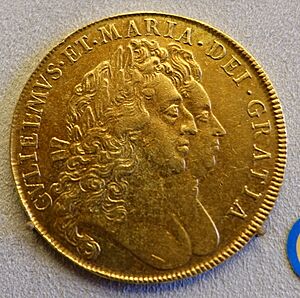
In December 1689, Parliament passed the Bill of Rights. This law set limits on the king's power. It said the ruler could not stop laws made by Parliament. They could not collect taxes without Parliament's approval. They could not have a standing army in peacetime without Parliament's consent. The Bill of Rights also confirmed who would rule next. After William or Mary died, the other would continue to reign. Then, any children they had, followed by Mary's sister Anne and her children.
From 1690 onwards, William was often away from England. He usually left in spring and returned in autumn. In 1690, he fought Jacobites (who supported James) in Ireland. William defeated the Irish Jacobites by 1692. But he continued fighting France in the Netherlands.
While her husband was away, Mary managed the government. She got advice from a nine-member council. She was not eager to take power. She felt "deprived of all that was dear to me in the person of my husband." She also felt alone among strangers. Her sister Anne had argued with William and Mary about money. The relationship between the sisters had become difficult.
When William was away, Mary made decisions on her own. But when he was in England, Mary did not get involved in politics. This was as agreed in the Bill of Rights, and what she preferred. However, she proved to be a strong ruler. She even ordered the arrest of her own uncle, Henry Hyde, 2nd Earl of Clarendon. He was planning to bring James II back to the throne.
In January 1692, John Churchill, an important leader, was fired for similar reasons. This made Mary less popular. It also hurt her relationship with Anne even more. Anne was very close to Churchill's wife, Sarah. Anne showed up at court with Sarah, clearly supporting Churchill. Mary angrily demanded that Anne fire Sarah and move out of her home.
Mary became ill with a fever in April 1692. She missed church for the first time in 12 years. She also did not visit Anne, who was having a difficult birth. After Mary got better and Anne's baby died, Mary did visit her sister. But she used the visit to scold Anne for being friends with Sarah. The sisters never saw each other again. Churchill was arrested but then released. Mary wrote in her journal that the sisters' argument was a punishment from God. She was very religious and prayed at least twice a day.
Many of Mary's rules focused on stopping drunkenness and bad behavior. She often took part in the affairs of the Church. All church appointments went through her. When Archbishop of Canterbury John Tillotson died in December 1694, Mary wanted to appoint Bishop of Worcester Edward Stillingfleet. But William chose Bishop of Lincoln Thomas Tenison instead.
Mary's Death
Mary was tall (5 feet 11 inches) and seemed healthy. She often walked between her palaces. It seemed likely she would live longer than her husband and sister, who both had health problems. But in late 1694, she caught smallpox. She sent away anyone who had not had the disease before. This was to stop it from spreading. Anne, who was pregnant again, sent Mary a letter. She said she would risk anything to see her sister. But Mary's attendant, the Countess of Derby, refused the offer.
A few days into her illness, the smallpox spots seemed to disappear. Her skin looked smooth. Mary said she felt better. Her helpers hoped she had measles, not smallpox, and was getting well. But the rash had "turned inward." This meant Mary had a very serious form of smallpox. Her condition quickly got worse. Mary died at Kensington Palace just after midnight on December 28. She was 32 years old.
William had come to rely on Mary more and more. He was heartbroken by her death. He said he was "now going to be the miserablest creature on earth." Some people who supported James thought her death was God's punishment. But most people in Britain mourned her deeply.
During a cold winter, her body was placed in Banqueting House, Whitehall. On March 5, she was buried at Westminster Abbey. Her funeral was the first royal funeral attended by members of both Houses of Parliament. For the ceremony, composer Henry Purcell wrote Music for the Funeral of Queen Mary.
Mary's Legacy
Mary helped start the College of William and Mary in Virginia in 1693. She also supported Thomas Bray, who started the Society for Promoting Christian Knowledge. She was important in setting up the Royal Hospital for Seamen, Greenwich. This was after a big naval victory against France.
Mary also influenced garden design at palaces like Het Loo and Hampton Court Palace. She helped make blue and white porcelain and keeping goldfish as pets popular.
People who supported James saw Mary as a disloyal daughter. They thought she hurt her father for her own gain. Early in her reign, some thought she was completely controlled by her husband. But after she ruled alone when William was away, she was seen as capable and confident. Writers praised her modesty and quiet nature. They said she took on a big task when needed, but was happy to give up power.
A week before she died, Mary went through her papers. She burned some, but her journal survived. Her letters to William and to Frances Apsley also remain. Even though some criticized her, Mary is remembered as a loyal wife. She took on power when necessary and ruled well. She was also happy to let her husband lead.
Titles and Styles
- April 30, 1662 – November 4, 1677: Her Highness The Lady Mary
- November 4, 1677 – February 13, 1689: Her Highness The Princess of Orange
- February 13, 1689 – December 28, 1694: Her Majesty The Queen
When William and Mary became rulers of England, their full title was: "William and Mary, by the Grace of God, King and Queen of England, France and Ireland, Defenders of the Faith, etc." After Scotland recognized them on April 11, 1689, their title became: "William and Mary, by the Grace of God, King and Queen of England, Scotland, France and Ireland, Defenders of the Faith, etc."
Images for kids
See also
 In Spanish: María II de Inglaterra para niños
In Spanish: María II de Inglaterra para niños


